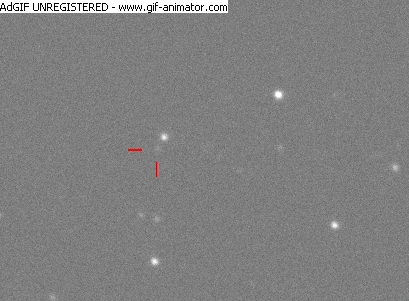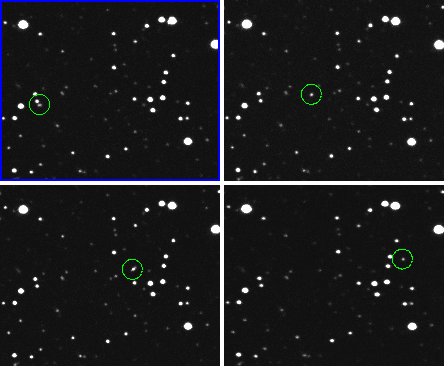[/caption]
A newly found space rock will give Earth a close shave on May 29, passing by at a distance of just 14,440 kilometers (8,950 miles). That distance puts the small asteroid, named 2012 KT42, in the top ten list of closest asteroid approaches. In fact, this is the sixth closest approach to date. The close pass will occur at about 07:00 UTC (03:00 EDT, midnight PDT in the US) on May 29. 2012 KT42 is estimated to be between 3-10 meters in size, and while there is no possibility this asteroid will hit Earth, even if it did, it would surely burn up in the atmosphere.
The sequence of images above were sent to us by Alex Gibbs from the Catalina Sky Survey, who made the discovery of 2012 KT42 with the 1.5 meter telescope on Mt. Lemmon, Arizona on May 28. Gibbs also discovered a similar sized asteroid earlier this year, 2012 BX34, and shared with Universe Today the behind the scenes activities in the discovery of a near-Earth asteroid.
This asteroid closely followed another close pass by a different asteroid, 2012 KP24, which passed by Earth on May 28 at a distance of about 51,000 kilometers (32,000 miles). This rock was bigger, about 25 meters (80 feet) across.
Below is an animation of images of 2012 KT42 taken by Ernesto Guido, Nick Howes and Giovanni Sostero from the Remanzacco Observatory.

The team said that at the time they took the images on May 28, 2012 KT42 was moving at about ~3.63 “/min and its magnitude was ~17.5. The images were take with the Siding Spring-Faulkes Telescope South through a 2.0-m f/10.0 Ritchey-Chretien telescope.
An interesting note pointed out by the Remanzacco team is that on May 29 at about 10:10 UT, 2012 KT42 will transit across the face of the Sun, and this could be seen from Africa, the Middle East, Asia. But it will be hard to see, if the diameter is about 5m, then the object would only appear about 0.006 of a degree against the solar disk.
In our article about Gibbs’ earlier discovery, he noted that when astronomers look through telescopes, asteroids don’t look much different from stars – they are just points of light. But asteroids are points of light which are moving; however they are moving slow enough that to detect the motion, astronomers take a series of images, usually four images spaced 10-12 minutes apart.
Then, the observers run specialized software to examine their images for any star-like objects that are moving from one image to the next. The software removes any candidates that correspond to known objects or main-belt asteroids. Gibbs said the software has a low detection threshold to avoid missing anything, so the observer looks over what the software found and determines which are real. The remaining objects that the software determines could be interesting are then sent in to the Minor Planet Center (MPC) at the Smithsonian Astrophysical Observatory in Cambridge, Massachusetts, for the team or others to follow up.
Thanks to Alex Gibbs and the Remanzacco team for sharing their images.
You can see more info about 2012 KT42 at JPL’s Small Body Database website, or at the Minor Planet Center.


If it would be a case, I wish, it had not burned up completely !
What time could this be from the Philippines?
Online Conversion
http://www.onlineconversion.com/timezone.php
TimeZone Convertor
http://www.timeanddate.com/worldclock/converter.html
The term asteroid has definitely been downgraded if we are including 3-10 meter objects.
A Wiki-(Look)Up describes the term asteroid as follows: “Size distribution
Asteroids vary greatly in size, from almost 1000 kilometres for the largest down to rocks just tens of metres across.[note 3] The three largest are very much like miniature planets: they are roughly spherical, have at least partly differentiated interiors, and are thought to be surviving protoplanets. The vast majority, however, are much smaller and are irregularly shaped; they are thought to be either surviving planetesimals or fragments of larger bodies.”
As far as I’m aware, the term asteroid has no formal definition (which if it did, would be set out by the IAU). I suspect that it is one of those things that is decided by scientific consensus – and nobody is really interested in making a career out of defining ‘asteroid’ when there’s so much more interesting stuff to be done, like finding out what they’re made of.
You’re right, it should most certainly be called a “meteoroid”.
Great catch! One might consider that instruments like the one used by the Catalina Sky Survey to discover this rock have not been around for all that long a time (30 years?). Or had the sensitivity to find objects like this until fairly recently… begs the question: Just how many stones like this have passed by us without being noticed at all?
Further, I wonder if this encounter is the first one for this rock? Remember that atmosphere skimming asteroid photographed over the Rockies in 8mm movie format back in the early 70’s? Hard or impossible to say… that stone would obviously had it’s orbital parameters changed by that encounter.
Do you actually get paid to crap up this site? How low can you go… scumbag.
They only discovered this yesterday and it’s going to pass us today. So what if it wasn’t going to pass by us, it was going to hit us and what if it wasn’t 10m across and instead was 1000m across? Doesn’t fill you with confidence that these objects can be discovered in time to do something about them.